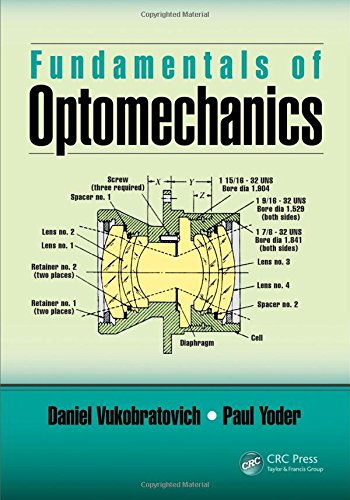Fundamentals of Optomechanics 1st Edition by Daniel Vukobratovich, Paul Yoder 1498770767 9781498770767
$50.00 Original price was: $50.00.$25.00Current price is: $25.00.
Fundamentals of Optomechanics 1st Edition by Daniel Vukobratovich, Paul Yoder – Ebook PDF Instant Download/DeliveryISBN: 1498770767, 9781498770767
Full download Fundamentals of Optomechanics 1st Edition after payment.

Product details:
ISBN-10 : 1498770767
ISBN-13 : 9781498770767
Author: Daniel Vukobratovich, Paul Yoder
When Galileo designed the tube of his first telescope, optomechanics was born. Concerned with the shape and position of surfaces in an optical system, optomechanics is a subfield of physics that is arguably as old as optics. However, while universities offer courses on the subject, there is a scarcity in textbook selections that skillfully and properly convey optomechanical fundamentals to aspiring engineers. Complemented by tutorial examples and exercises, this textbook rectifies this issue by providing instructors and departments with a better choice for transmitting to students the basic principles of optomechanics and allowing them to comfortably gain familiarity with the field’s content. Practicing optical engineers who engage in self-study and wish to enhance the extent of their knowledge will also find benefit from the vast experience of the authors. The book begins with a discussion of materials based on optomechanical figures of merit and features chapters on windows, prisms, and lenses. The authors also cover topics related to design parameter, mounting small mirrors, metal mirrors with a discussion of infrared applications, and kinematic design. Overall, Fundamentals of Optomechanics outfits students and practitioners with a stellar foundation for exploring the design and support of optical system surfaces under a wide variety of conditions. Provides the fundamentals of optomechanics Presents self-contained, student-friendly prose, written by top scientists in the field Discusses materials, windows, individual lenses and multiple lenses Includes design, mounting, and performance of mirrors Includes homework problems and a solutions manual for adopting professors
Fundamentals of Optomechanics 1st Table of contents:
Chapter 1 Introduction
1.1 Introduction and Summary
1.2 Development of Optomechanics
1.3 General Considerations
1.4 Prerequisites
References
Chapter 2 Optomechanical Design Process
2.1 Introduction and Summary
2.2 Establishing the Requirements
2.3 Conceptualization
2.4 Performance Specifications and Design Constraints
2.5 Preliminary Design
2.6 Design Analysis and Computer Modeling
2.7 Error Budgets and Tolerances
References
Chapter 3 Material Selection
3.1 Introduction and Summary
3.2 Optical Figures of Merit
3.3 Structural Figures of Merit
3.4 Thermal Figures of Merit
3.5 Strength of Brittle Optical Materials
3.6 Optical Glass
3.7 Optical Plastics
3.8 Infrared Materials
3.9 Mirror Substrate Materials
3.10 Material Cost
Problems
References
Further Reading
Chapter 4 Window Design and Mounting
4.1 Introduction and Summary
4.2 Window Design
4.2.1 Optical Performance of Windows
4.2.2 Window Strength
4.2.3 Mounting Flat Windows
4.3 Domes
4.3.1 Dome Strength
4.3.2 Dome Mounting
Problems
References
Further Reading
Chapter 5 Mounting Individual Lenses
5.1 Introduction and Summary
5.2 Centering Optics
5.3 Lens Mass and Center of Gravity Location
5.3.1 Estimating Lens Mass
5.3.2 Lens Center of Gravity Location
5.4 Lens Axial Preload
5.4.1 General Considerations
5.4.2 Threaded Retaining Ring Mounting
5.4.3 Continuous Flange Mounting
5.4.4 Multiple Cantilever Spring Clip Mounting
5.5 Lens Bending
5.5.1 Bending Stress
5.5.2 Self-Weight Deflection of Lenses
5.6 Surface Contact Optomechanical Interfaces
5.6.1 Sharp Corner Interface
5.6.2 Tangential Interface
5.6.3 Toroidal Interface
5.6.4 Spherical Interface
5.6.5 Interfaces on Bevels
5.6.6 Parametric Evaluation of Contact Stress
5.7 Elastomeric Ring Mountings for Lenses
5.8 Stress Effects at the Optomechanical Interface
5.8.1 Compressive and Tensile Stresses in Optics
5.8.2 Stress Birefringence
5.9 Mounting Low-Precision Lenses
5.9.1 Low-Precision Lens Mounts
5.9.2 Spring-Loaded Mountings
5.9.3 Burnished Cell Mountings
5.9.4 Snap Ring Mountings
5.10 Mounting Plastic Lenses
Problems
References
Further Reading
Chapter 6 Mounting Multiple Lenses
6.1 Introduction
6.2 Lens Barrel Structural Design
6.3 Multielement Spacing Considerations
6.3.1 Lens Location Interfaces
6.3.2 Self-Centering
6.3.3 Calculating Spacing
6.4 Effects of Temperature Changes
6.4.1 Radial Effects of Temperature Changes
6.4.2 Radial Clearance Change with Temperature
6.4.3 Radial Thermal Stress in the Optic
6.4.4 Thermal Change in Spacing
6.4.5 Change in Axial Preload with Temperature
6.4.6 Thermal Stress in Bonded Lenses
6.4.7 Focus Shift with Temperature
6.5 Lathe Assembly
6.6 Subcell Assembly
6.7 Plastic Lens Mounting
Problems
References
Further Reading
Chapter 7 Techniques for Mounting Prisms
7.1 Introduction and Summary
7.2 Kinematic, Semikinematic, and Nonkinematic Principles
7.3 Prism Mass
7.4 Mounting Prisms by Clamping
7.4.1 Clamped Prism Mounts: Kinematic
7.4.2 Clamped Prism Mounts: Semikinematic
7.4.3 Clamped Prism Mounts: Nonkinematic
7.5 Mounting Prisms by Adhesive Bonding
7.5.1 General Considerations
7.5.2 Typical Applications
7.5.3 Double-Sided Prism Supports
Problems
References
Further Reading
Chapter 8 Factors Affecting Mirror Performance
8.1 Introduction and Summary
8.2 Tolerances, Error Budgets, and Superposition
8.3 Gravity Deflections
8.3.1 General Considerations
8.3.2 Axial Gravity Deflection
8.3.3 Optimum Axial Support Locations
8.3.4 Factors Influencing Axial Self-Weight Deflection
8.3.5 Small-Mirror Approximation
8.3.6 Mirror Deformation from Mounting
8.3.7 Scanning Mirror Deformation
8.4 Dynamic Effects on Mirrors
8.4.1 General Considerations
8.4.2 Diaphragm Frequency of a Mirror
8.4.3 Rigid-Body Frequencies of an Axisymmetric Mirror
8.4.4 Damping
8.4.5 Rigid-Body Response to Dynamic Excitation
8.5 Thermal Effects
8.5.1 General Considerations
8.5.2 Uniform Change in Temperature
8.5.3 Temperature Gradients
8.5.4 Anisotropy of Coefficient of Thermal Expansion
8.5.5 Thermal Inertia
Problems
References
Chapter 9 Design and Mounting of Small Mirrors
9.1 Introduction and Summary
9.2 General Considerations
9.2.1 Defining Small Mirrors
9.2.2 Mirror Applications
9.2.3 Geometric Configurations
9.2.4 Reflected Image Orientation
9.2.5 Beam Prints on Optical Surfaces
9.2.6 Mirror Coatings
9.2.7 Ghost Image Formation by Second-Surface Mirrors
9.3 Semikinematic Mountings for Small Mirrors
9.4 Mounting Mirrors by Bonding
9.4.1 Single and Multiple Bonds on Mirror Backs
9.4.2 Annular Ring Mounts
9.5 Flexure Mounts for Small Mirrors
Problems
References
Further Reading
Chapter 10 Design and Mounting of Metallic Mirrors
10.1 Introduction and Summary
10.2 General Considerations of Metal Mirrors
10.3 Aluminum Mirrors
10.4 Beryllium Mirrors
10.5 Mirrors Made from Other Metals
10.5.1 General Considerations
10.5.2 Copper Mirrors
10.5.3 Molybdenum Mirrors
10.5.4 Silicon Carbide Mirrors
10.6 Plating of Metal Mirrors
10.7 Single-Point Diamond Turning of Metal Mirrors
10.8 Conventional Mountings for Metal Mirrors
10.9 Integral Mountings for Metal Mirrors
10.10 Interfacing Multiple SPDT Components to Facilitate Assembly and Alignment
Problems
References
Further Reading
Chapter 11 Kinematic Design and Applications of Flexures
11.1 Introduction And Summary
11.2 Controlling Degrees of Freedom
11.2.1 Beauty of Static Determined Designs
11.2.2 Controlling One DOF
11.2.3 Controlling Two DOFs
11.2.4 Controlling Three DOFs
11.2.5 Controlling Four DOFs
11.2.6 Controlling Five DOFs
11.2.7 Controlling Six DOFs
11.2.8 Internal DOFs
11.2.9 Quasi-Static DOF Constraints
11.3 Structural Elements Used to Control DOFs
11.3.1 Strut (One DOF)
11.3.1.1 Stiffness Properties
11.3.1.2 Reduced Buckling
11.3.1.3 Improving the Tension-to-Bending Stiffness Ratio
11.3.2 Leaf Spring (Three DOFs)
11.3.3 Constricted Leaf Spring (Two DOFs)
11.3.4 Elastic Hinge (One DOF)
11.3.5 Approximated Elastic Hinges (Two DOFs or Five DOFs)
11.3.6 Folded Leaf Spring (One DOF)
11.3.7 Contact Stresses with Various Interface Geometries
11.3.7.1 Sphere-on-a-Flat Plate
11.3.7.2 Sphere in a V-Groove
11.3.7.3 Sphere in a Cone
11.4 Mounting and Constraining DOFs of Optomechanical Components
11.4.1 Mounting Optomechanical Components
11.4.1.1 Component Shape
11.4.1.2 Mounting Transmitting or Reflecting Optics
11.4.1.3 Thermal Stresses due to Temperature Changes
11.4.1.4 Thermal Isolation
11.4.1.5 Quantity or One-Off Production
11.4.2 Alternate Mounting Methods
11.4.2.1 Three Leaf Springs
11.4.2.2 Kinematic Mount
11.4.2.2.1 Contact Stress
11.4.2.2.2 Thermal Center
11.4.2.2.3 Thermal Gradients
11.4.2.2.4 Friction
11.4.2.2.5 Position Uncertainty
11.4.2.2.6 Some Variations on the Kinematic Mount
11.4.2.3 Kelvin Clamp
11.4.2.4 Six Struts
11.5 Alignment of Optics by Controlling the DOFs
11.5.1 Alignment
11.5.2 Alignment Stability
People also search for Fundamentals of Optomechanics 1st:
fundamental optical design
fundamental optical design pdf
fundamentals for ophthalmic technical personnel
fundamentals of optics and photonics
fundamentals of optics an introductory course
Tags: Fundamentals, Optomechanics, Daniel Vukobratovich, Paul Yoder
You may also like…
Business & Economics
Politics & Philosophy
Computers - Programming
Engineering Mathematics - Analysis
Politics & Philosophy - Social Sciences
Computers - Programming
Fiction - American Fiction











